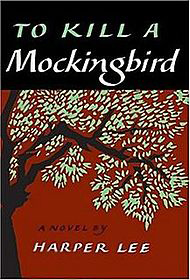
Source: To Kill A Mockingbird, Wikipedia
Someone named “Boo” is a man to fear, or so thought the Finch children in Harper Lee’s classic novel, To Kill a Mockingbird. Boo Radley, a neighbor of the Finches in Maycomb, Alabama, was a recluse, or a man who kept to himself. When Boo was a teenager, he was arrested for disorderly conduct. Rather than see his son sent to a state industrial school for his misdemeanors, Mr. Radley convinced the judge that he would see to it that Boo did not get in any more trouble. Confined to the Radley house, Boo stayed out of trouble until he was thirty-three when he drove a pair of scissors into his father’s leg. That incident fueled the imagination of many townspeople who saw Boo as a malevolent phantom—or evil spirit—with the power to kill flowers by breathing on them. Narrator Scout Finch lists the unlikely misfortunes that neighbors attributed to Boo Radley.
Inside the house lived a malevolent phantom. People said he existed, but Jem and I had never seen him. People said he went out at night when the moon was down, and peeped in windows. When people’s azaleas froze in a cold snap, it was because he had breathed on them. Any stealthy small crimes committed in Maycomb were his work. Once the town was terrorized by a series of morbid nocturnal events: people’s chickens and household pets were found mutilated; although the culprit was Crazy Addie, who eventually drowned himself in Barker’s Eddy, people still looked at the Radley Place, unwilling to discard their initial suspicions. A Negro would not pass the Radley Place at night, he would cut across to the sidewalk opposite and whistle as he walked. The Maycomb school grounds adjoined the back of the Radley lot; from the Radley chickenyard tall pecan trees shook their fruit into the schoolyard, but the nuts lay untouched by the children: Radley pecans would kill you. A baseball hit into the Radley yard was a lost ball and no questions asked.
In 1962 Horton Foote won an Academy Award for his screen play of Harper Lee’s novel To Kill a Mockingbird. In this scene, Jem and Scout Finch talk with Dill about Boo and hear Aunt Stephanie’s opinion of the Radleys. As you watch, listen carefully to determine if the Jem, Scout, and Aunt Stephanie are as imaginative and “loose with the facts” as others in Maycomb.
Source: "My Lord, Aunt Stephanie, you almost gave me a heart attack!", okidokivideos, Youtube
What does ten-year-old Jem say about Boo that leads you to believe he might be exaggerating?
Boo is chained to his bed and judging from his tracks, he’s six and a half feet tall, eats raw squirrels and all the cats he can catch.
What does Aunt Stephanie add that leads you to believe she is exaggerating too?
Dill should believe everything Jem and Scout are telling him – that Boo is a dangerous maniac sitting at his house with his scissors.
The imaginative trio fills the idle days of summer vacation with theatrics, creating a play about the neighborhood boogeyman. Their villain is 6½ feet tall, has a jagged scar on his face, has yellow, rotting teeth, and drools.
It was a melancholy little drama, woven from bits and scraps of gossip and neighborhood legend: Mrs. Radley had been beautiful until she married Mr. Radley and lost all her money. She also lost most of her teeth, her hair, and her right forefinger (Dill’s contribution. Boo bit it off one night when he couldn’t find any cats and squirrels to eat.); she sat in the living room and cried most of the time, while Boo slowly whittled away all the furniture in the house.